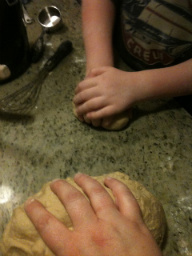August 5, 2019 - 7:52am

Holey bread a fad?
I have memories from childhood of toasting bread and being annoyed and at big holes in bread that would be hard to work with for spreading butter or peanut butter. Yes, you wanted the bread to be airy, but not necessarily holey. You only wanted English muffins to have holes (with a firm bottom) to catch the butter and jam that fell into the nooks and crannies, but holey bread was the pits.
Fast forward to now and it's like "the holier the better".
Is this a fad? or will it stick around? And if it is a fad, what do you predict will be the next one?


:)
I think there is a resurgence of the fad now there are a few youtube videos that if you follow step by step will lead you to the holey land.
Consider that Trevor Wilson wrote his blog post about Tartine Envy in 2016, and when he wrote it, everyone and their mother were baking like beasts to achieve that perfect holey crumb. For what it's worth. ?
I’ll paste in here my answer to the same question posted just over a year ago by justanoldguy:
~~~
I believe it's the Internet. Of our five senses, we experience food with vision, feel, taste and smell but rarely sound (although a well crusted bread will "sing" when removed from the oven -- we can be thankful that FLoafers are not inviting others to listen to their loaves, yet). The Internet is a medium of vision and sound and not yet feel, taste or smell. So we're left with vision. Broadband Internet and high-res computer monitors now readily reproduce photographic and cinematic reality. This has inordinately focused online bread enthusiasm on visual aspects of the product: crust and crumb structure and color. The timing of Trevor Wilson's title couldn't be more appropriate. Every time I read someone commenting here, "It must taste great", I wonder when we'll be able to say, "It sure tastes great".
That being said, there is theoretically a flavor benefit associated with alveoli dimension. In a properly fermented dough, the interior surfaces of the alveoli become gelated (or "gelatinized" - although it's hardly "gelatin" in there) with heat transformed carbohydrates and polysaccharides. That glossiness is a sign of proper fermentation and with it, depth of flavor, contributed to some extent by the glossy surface itself (I cannot personally attest to that - tasting just that surface is a challenge). Presumably there is an association between alveoli size and that glossiness although I wouldn't bet that small alveoli can't be just as glossy -- they just don't show it because their edges shade the interior, obscuring reflections.
So alveoli volume -- always 2D online, in cross-section -- is a proxy for proper, thorough fermentation and thus implies deep and maximal flavor. But there must be limits, no? At some point along the brick–>Tartine continuum, a limit is reached beyond which the cost (in spilled jam or butter abuse) outweighs the flavor benefits. Shao-ping, past master and beloved Fresh Loaf regular, memorably declared, in response to this creeping trend at the time, "Well you can't eat the holes!". True, but that doesn't mean they don't deliver something worth striving for besides the low-cal nutritional benefit of air.
Tom
Oh, I did a quick search and didn't see it - I must have used different search terms.
I also thought about how bread that is less dense, are less caloric (in a way) because if you are used to eating ONE slice and those slices have more holes in them, you are eating less. I opt to eat bread that will fill me up more and keep me filled versus breads that are made with mostly white flour, but we all do what we do for flavor, and preferences.
Thanks for copying and pasting too. I totally didn't think about how we eat with our eyes too. All my early bread books are without pictures. Actually ALL my go-to bread books are without pictures!
... I'm reminded of my Dad, who thought big-hole bread was a swindle, an effort to make less bread look like more bread.
You know what? I think someone in my family said the same thing! I had totally forgotten that!
This makes excellent sense. There's a nice, chewy texture that the big holes can get you. Not what I do all the time, but useful as part of the range.
But, while it's not my thing, I totalllllly understand wanting to be able to do a new technique. That's one thing I like about all cooking - picking up new skills. The challenge sucks me in!
I agree with Melissa. Open crumb is a skill set that I would very much like to be able to produce on demand. But for me a lacy honeycomb crumb is the cat’s meow...
It grieves me to read that a baker new to sourdough is disappointed with a beautiful loaf they baked because his crumb is not super open like those of the bread gods :-(
I well remember the days when “bricks” were common for new bakers. Today, technique and knowledge abounds. Happy to say, bricks are rare for TFL bakers. Although it does mean that we will have to buy our door stops. God knows, I’ve made my share of them in decades past...
Danny
Since I have not really been aiming for super big holes in my bread, I’m quite happy with lace like crumb that I have been able to achieve. When I’ve seen some of the super open crumb I agree that I wonder how well it could be used to hold certain toppings or spreads.
Thank you for the post and replies. As a new baker, it puts a few things in perspective.